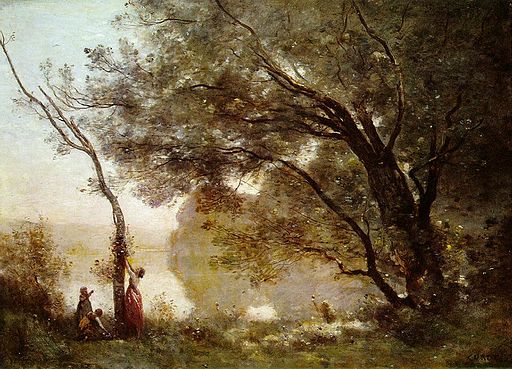
Ville d’Avray, 1867
Jean-Baptiste-Camille Corot was born in Paris on July 16, 1796. He was a giant of the Barbizon school and humbled his contemporaries with brushwork that almost defies description along with a poet's understanding of light. His landscapes speak. The trees themselves are like figures in a scene. And yet he could also paint people quite well, bathing women in soft light and delicate features like the landscapes of his French countryside. In the Renaissance and Baroque the landscape was often depicted in sunrise or glowing sunset, as if revealing the untapped potential of humanity itself, whereas with Corot overcast skies and trees blowing in the wind foreshadow the progress of man looming over nature. He still manages to make breathtaking work in the process.
In Ville d’Avray he makes the ordinary surreal, using strong horizontals but makes the two trees vibrate with his characteristic blurred brushstrokes that are even more impressive seen in person. Corot realized early on in his career that painting or even suggesting every leaf would be tiresome in such a landscape without figures. Instead, the Impressionism he anticipates gives a glow to the foliage, and he makes the branches and trunks sharp and dark. Note the accurate reflection of the buildings in the water. The haze of the blue sky above them lightens the dark foreground elements, and we see a tranquil scene that invites us to participate.

Souvenir de Mortefontaine, ca.1864
Sunlight shimmers in the lake behind this beautiful scene, a relatively rare occurrence for Corot. Note how the massive diagonal lines of the big tree are mimicked by the smaller one on the left, where three figures are dwarfed by them. Nature itself is the subject with Corot, and although there is more suggestion of details in the foliage here it is color and light that dominate this work. Atmospheric perspective is used to a poetic grace here that few painters have been able to create. Squint your eyes and that water with reflected trees glows with perfect values, and the highlights of the grass underneath the big tree, as well as how the sky pokes through the tree foliage...this is pure heaven.

Nymphes and Fauns, ca.1870
A more sombre piece that is more typical of Corot, this time he contrasts dancing figures against the faint glow of a setting sun beneath an overcast sky. Strong verticals dominate here, and instead of dark shadows Corot fills them with warm greens and yellows, with a small area of clear water to divide the ground in half. Corot conjures a world here without any technology or interference with nature whatsoever...pure harmony and poetry.

La Femme à la perle, ca.1869
Here Corot proves he is definitely no slouch in the portrait arena. Delicate facial features, graceful gesture, and a soft, warm light, Notice the thin wreath of leaves around her hair. Corot sees true beauty as something without status or social class, but pure in the way nature made her. Innocent. Captivating. This is the work of a painter made dreams out of the banal.
Comments
Post a Comment